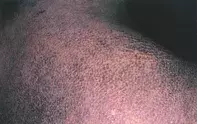What’s the diagnosis?
Itchy, rippled skin pigmentation

Figure 1. Marked rippled hyperpigmentation over the upper back.

Figure 2. Skin biopsy demonstrating orange fluorescence of deposits stained with Congo red in the superficial dermis.
Differential Diagnosis
Chronic dermatitis associated with intense itching and chronic rubbing may lead to a rugose, thickened skin with accentuated skin markings (lichen simplex chronicus) and hyperpigmentation. Skin biopsy shows a thickened epidermis with superficial dermal fibrosis and lymphocytic inflammation.
Lichenoid drug eruptions and widespread lichen planus may produce an intensely itchy skin eruption consisting of small violaceous papules that may heal with rippled, diffuse, ashy hyperpigmentation. The patient’s drug history should be reviewed and the buccal mucosa should be examined for a lace-like white network. Along with a preceding history of violaceous lesions, this may provide a correct diagnosis. Skin biopsy shows an intense lymphocytic infiltrate with degeneration of basal keratinocytes in the epidermis.
Primary cutaneous amyloidosis (lichen amyloidosis) is the correct diagnosis in this case. It is a skin disorder seen more commonly in Asian people. Skin biopsy showed a thickened epidermis. Under this were diffuse deposits that stained positively with Congo red dye, producing a green–red birefringence under polarised light and an orange fluorescence on UV microscopy (Figure 2).
The dermal deposits represent aggregates of keratin filaments derived from the overlying epidermis. In contrast, in primary systemic amyloidosis associated with myeloma, the deposits are composed of immunoglobulin light chains, and the haemorrhagic skin deposits are often asymptomatic and localised to the tongue, periorbital tissue or acral areas. The intense itching in primary cutaneous amyloidosis may be partially relieved by emollients or topical fluorinated steroids, but is often difficult to control. The oral retinoid acitretin, in a dose of 25 to 75 mg/day, has helped resolve some cases of cutaneous amyloidosis. Other treatments with variable response include UV therapy and pulsed dye laser therapy.
Over a six-year period, a 39-year-old man developed widespread intense itching associated with dark-brown rippled skin pigmentation over his trunk (Figure 1) and limbs.

